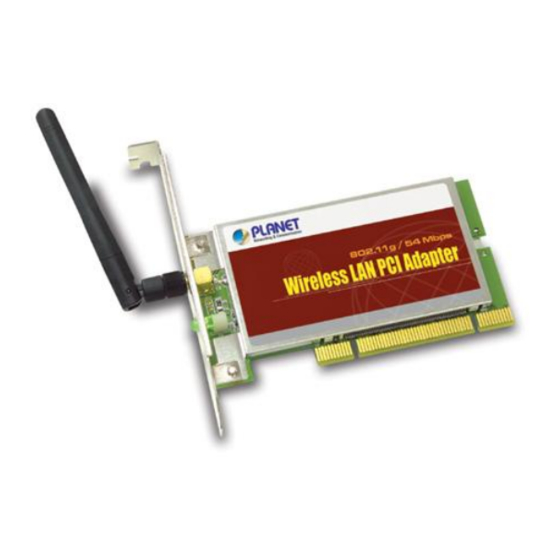Table of Contents
Advertisement
Quick Links
Advertisement
Table of Contents

Summary of Contents for Planet WL-8310
- Page 1 IEEE802.11g Wireless PCI Card WL-8310 User Manual...
- Page 2 Copyright Copyright 2003 by PLANET Technology Corp. All rights reserved. No part of this publi- cation may be reproduced, transmitted, transcribed, stored in a retrieval system, or trans- lated into any language or computer language, in any form or by any means, electronic, mechanical, magnetic, optical, chemical, manual or otherwise, without the prior written per- mission of PLANET.
- Page 3 The ETSI version of this device is also authorized for use in EFTA member states Iceland, Liechtenstein, Norway and Switzerland. Potential restrictive use France: Only channels 10,11,12 and 13 Revision User’s Manual for PLANET IEEE802.11g Wireless PCI Card Model: WL-8310 Rev: 1.0 (July, 2003) Part No. EM-WL8310V1...
-
Page 4: Table Of Contents
Manual Contents CHAPTER 1 INTRODUCTION ..........1 1.1 F ....................1 EATURES 1.2 A ..................2 PPLICATIONS 1.3 S ..................4 PECIFICATION 1.4 P ................4 ACKAGE ONTENTS 1.5 M ............4 INIMUM YSTEM EQUIREMENTS 1.6 SAFETY PRECAUTION ................ 5 1.7 I .............. -
Page 5: Chapter 1 Introduction
Chapter 1 Introduction The WL-8310 is an IEEE 802.11g Wireless PCI card that can operate in either Ad-Hoc mode (Point to Point/Point to Multipoint without an Access Point) or Infrastructure mode (Point to Point/Point to Multipoint with an Access Point). With almost 5 times the data rate of traditional 802.11b products, it is suitable for multimedia applications which require more bandwidth. -
Page 6: Applications
BSS must be configured with a BSS ID cor- responding to the WL-8310 used in the BSS. Check your WL-8310 for its BSS ID or use the Site Survey function on Configuration Utility program to determine the BSS ID. - Page 7 1.2.2 Ad-Hoc An Ad-Hoc wireless LAN is a group of computers, each equipped with one WL-8310 adapter or other wireless adapters, connected as an independent wireless LAN. Com- puters in a specific Ad-Hoc wireless LAN must be configured to share the same radio channel.
-
Page 8: Specification
1.3 Specification Product IEEE802.11g Wireless PCI Card Model Name WL-8310 Attachment Interface PCI V2.2 LED Indicators Steady for power on; blink for WLAN link/act Operating Frequency / 2.412~2.462GHz (FCC, USA & Canada) / 11 Channels Channel 2.412~2.4835GHz (TELEC, Japan) / 14 Channels 2.412~2.472GHz (ETSI, Europe) / 13 Channels... -
Page 9: Safety Precaution
1.6 SAFETY PRECAUTION Only use the accessories attached with the device package. Otherwise, the device may not function. If you miss or damage the accessories, please contact your local dealer. 1.7 Installation Considerations Please keep the number of walls and ceilings between the Access Point and clients as less as possible. -
Page 10: Chapter 2 Installation Procedure
2.1 Configuration Utility Installation Please install the configuration utility before insert WL-8310 into the PCI slot of the computer. 1. Insert the CD-ROM into the CD-ROM drive to initiate the autorun program. Once completed a menu screen will appear as follows. - Page 11 3. You can click “Browse” to specify the Destination Folder that you want to install the configuration utility. Or you can keep the default setting and click ”Next” to continue. 4. Select the program folder you want to install this utility to. Or you can keep the default setting and click ”Next”...
-
Page 12: Windows 98/Me/2000/Xp/Server 2003 Driver Installation
Note: The following installation operates under Windows XP. Procedures will be similar to other operating system. 1. Power off the computer. Insert WL-8310 to a vacant PCI slot and turn on the computer. 2. The “Found New Hardware Wizard” screen will appear. Please select “Install from a specific location (Advanced)”... - Page 13 4. A dialogue box will pop up. Click “Continue Anyway” to continue. 5. Click “Finish” to complete the installation.
-
Page 15: Chapter 3 Configuration Utility
Chapter 3 Configuration Utility The Configuration Utility is a powerful application that helps you to configure the WL-8310 and monitor the status of the communication process. By double click the icon on the system tray, the dialog box as below appears. -
Page 16: Configuration
3.2 Configuration In this screen, you can configure the wireless settings of WL-8310. After configuration, please press ”Apply” to save settings or “Cancel” to set again. SSID: The SSID must be identical for each clients and nodes in the wireless network. -
Page 17: Advanced
IEEE 802.11b). At the receiver, the Preamble and header are processed to aid in de- modulation and delivery of the PSDU. The Short Preamble and header may be used to minimize overhead and, thus, maximize the network data throughput. However, the Short Preamble is supported only from the IEEE 802.11b (High-Rate) standard and not from the original IEEE 802.11. -
Page 18: Site Survey
3.4 Site Survey This screen shows the APs or Adapters which available fro WL-8310 to connect. If you con- figure the SSID of WL-8310 as “Any”, it will show the available APs and Adapters at the same time. Click “ Refresh “ to collect the BSSID and Channel information of all the wireless devices around you. -
Page 19: Appendix
Appendix This section provides some technology Q&A. Read the description below to know more about the wire- less network. ü What is the difference between 54Mbps and 11Mbps wireless products? What’s the benefit of 54Mbps Wireless Access Point? The 54Mbps is made possible by the new modulation method called OFDM, which is different from the current CCK modulation method for 11Mbps. - Page 20 changed or dynamically assigned by the network, the MAC address of a networking device is permanent. ü What is WEP? Wired Equivalent Privacy (WEP) is a type of data encryption mechanism described in the IEEE 802.11 standard. ü Could I implement the driver/utility installations on another operating system, e.g. Windows 98SE, 2000 and ME? Are there any differences of driver/utility installa- tions among these different operating systems? Yes, you can.















